
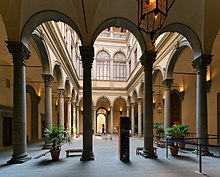

Palazzo Strozzi is a palace in Florence, Italy. It is located in the historic centre between the homonymous Via Strozzi and Piazza Strozzi, and Via Tornabuoni.



Palazzo Strozzi is a palace in Florence, Italy. It is located in the historic centre between the homonymous Via Strozzi and Piazza Strozzi, and Via Tornabuoni.
The construction of the palace was begun in 1489 [1] by Benedetto da Maiano, for Filippo Strozzi the Elder, a rival of the Medici who had returned to the city in November 1466 and desired the most magnificent palace to assert his family's continued prominence and, perhaps more important, [2] a political statement of his own status. [3] A great number of other buildings were acquired during the 1470s and demolished to provide enough space for the new construction. Giuliano da Sangallo provided a wood model of the design. [4] Filippo Strozzi died in 1491, long before the construction's completion in 1538. Duke Cosimo I de' Medici confiscated it in the same year, not returning it to the Strozzi family until thirty years later.
The palace faces the historical Via de' Tornabuoni.
Palazzo Strozzi is an example of civil architecture with its rusticated stone, [5] inspired by the Palazzo Medici, but with more harmonious proportions. Unlike the Medici Palace, which was sited on a corner lot, and thus has only two sides, this building, surrounded on all four sides by streets, is a free-standing structure. This introduced a problem new in Renaissance architecture, which, given the newly felt desire for internal symmetry of planning symmetry: how to integrate the cross-axis. The ground plan of Palazzo Strozzi is rigorously symmetrical on its two axes, with clearly differentiated scales of its principal rooms. [6]
The palazzo has mullioned paired windows (bifore); the radiating voussoirs of the arches increase in length as they rise to the keystone, a detail that was much copied for arched windows set in rustication in the Renaissance revival. Its dominating cornice is typical of the Florentine palaces of the time.

The palace was left incomplete by Simone del Pollaiolo (il Cronaca), who was in charge of the construction of the palace until 1504. Also by Cronaca is the cortile or central courtyard surrounded by an arcade, [7] inspired by Michelozzo.
Wrought-iron objects known as ferro that adorn the building are famous. Many of these appointments to the building, such as flagpole and torch stands, hitches, lanterns, and sconces decorate the palace exterior and its corners as well as filling functional needs of the day. The ferro on the building were created by an ironsmith, Niccolo Grosso, known as Il Caparra.
The palazzo remained the seat of the Strozzi family until 1937. Great changes were made to the building when the Istituto Nazionale delle Assicurazioni occupied Palazzo Strozzi. The palazzo, granted by the Istituto Nazionale delle Assicurazioni to the Italian State in 1999, is now home to the Institute of Humanist Studies and to the Fondazione Palazzo Strozzi. The Gabinetto G.P. Viesseux and the Renaissance Studies Institute have both also occupied the building since 1940. Today the palace is used for international expositions like fashion shows and other cultural and artistic events, such as "Cézanne in Florence. Two Collectors and the 1910 Exhibition of Impressionism". Here also is the seat of the Istituto Nazionale del Rinascimento and the noted Gabinetto Vieusseux , with the library and reading room.
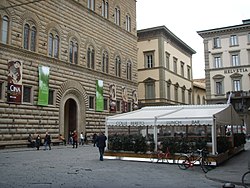
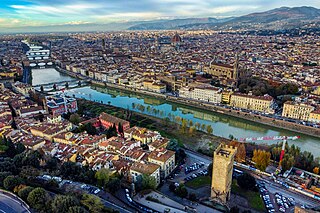
Florence is the capital city of the Italian region of Tuscany. It is also the most populated city in Tuscany, with 364,073 inhabitants in 2024, and 990,527 in its metropolitan area.

The Pazzi were a powerful family in the Republic of Florence. Their main trade during the fifteenth century was banking. In the aftermath of the Pazzi conspiracy in 1478, members of the family were banished from Florence and their property was confiscated; the family name and coat-of-arms were permanently suppressed by order of the Signoria.

Santa Maria Novella is a church in Florence, Italy, situated opposite, and lending its name to, the city's main railway station. Chronologically, it is the first great basilica in Florence, and is the city's principal Dominican church.

The Republic of Florence, known officially as the Florentine Republic, was a medieval and early modern state that was centered on the Italian city of Florence in Tuscany, Italy. The republic originated in 1115, when the Florentine people rebelled against the Margraviate of Tuscany upon the death of Matilda of Tuscany, who controlled vast territories that included Florence. The Florentines formed a commune in his successors' place. The republic was ruled by a council known as the Signoria of Florence. The signoria was chosen by the gonfaloniere, who was elected every two months by Florentine guild members.
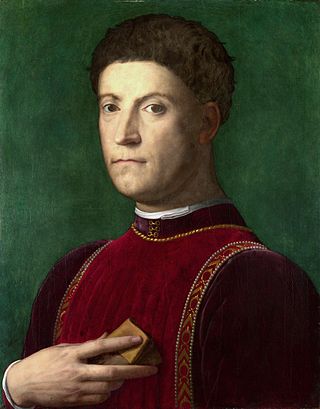
Piero di Cosimo de' Medici, known as Piero the Gouty, was the de facto ruler of Florence from 1464 to 1469, during the Italian Renaissance.

Giuliano da Sangallo was an Italian sculptor, architect and military engineer active during the Italian Renaissance. He is known primarily for being the favored architect of Lorenzo de' Medici, his patron. In this role, Giuliano designed a villa for Lorenzo as well as a monastery for Augustinians and a church where a miracle was said to have taken place. Additionally, Giuliano was commissioned to build multiple structures for Pope Julius II and Pope Leo X. Leon Battista Alberti and Filippo Brunelleschi heavily influenced Sangallo and in turn, he influenced other important Renaissance figures such as Raphael, Leonardo da Vinci, his brother Antonio da Sangallo the Elder, and his sons, Antonio da Sangallo the Younger and Francesco da Sangallo.

The Bargello, also known as the Palazzo del Bargello or Palazzo del Popolo, is a former public building and police headquarters, later a prison, in Florence, Italy. Mostly built in the 13th century, since 1865 it has housed the Museo Nazionale del Bargello, a national art museum.
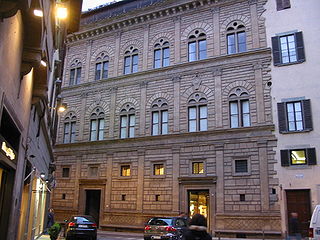
Palazzo Rucellai is a palatial fifteenth-century townhouse on the Via della Vigna Nuova in Florence, Italy. The Rucellai Palace is believed by most scholars to have been designed for Giovanni di Paolo Rucellai by Leon Battista Alberti between 1446 and 1451 and executed, at least in part, by Bernardo Rossellino. Its splendid facade was one of the first to proclaim the new ideas of Renaissance architecture based on the use of pilasters and entablatures in proportional relationship to each other. The Rucellai Palace demonstrates the impact of the antique revival but does so in a manner which is full of Renaissance originality.

Piazza della Signoria is a w-shaped square in front of the Palazzo Vecchio in Florence, Italy. It was named after the Palazzo della Signoria, also called Palazzo Vecchio. It is the main point of the origin and history of the Florentine Republic and still maintains its reputation as the political focus of the city. It is the meeting place of Florentines as well as the numerous tourists, located near Palazzo Vecchio and Piazza del Duomo, and gateway to the Uffizi Gallery.

The Palazzo Medici, also called the Palazzo Medici Riccardi after the later family that acquired and expanded it, is a 15th-century Renaissance palace in Florence, Italy. It was built for the Medici family, who dominated the politics of the Republic of Florence. It is now the seat of the administration of the Metropolitan City of Florence and a museum.

The House of Strozzi is the name of an ancient Florentine family, who like their great rivals the House of Medici, began in banking before moving into politics. Until its exile from Florence in 1434, the Strozzi family was by far the richest in the city, and was rivaled only by the Medici family, who ultimately took control of the government and ruined the Strozzi both financially and politically. This political and financial competition was the origin of the Strozzi-Medici rivalry. Later, while the Medici ruled Florence, the Strozzi family ruled Siena, which Florence attacked, causing great animosity between the two families. Soon afterward, the Strozzi married into the Medici family, essentially giving the Medici superiority.

Filippo Strozzi the Younger was a Florentine banker, and the most famous member of the Strozzi family in the Renaissance. He is best remembered as a tragic hero and defender of the lost Florentine republic against the Medici dukes – yet this is almost entirely a nineteenth-century fiction of nationalist historians and dramatists. He had been one of the staunchest supporters of the House of Medici in Florence and Rome.
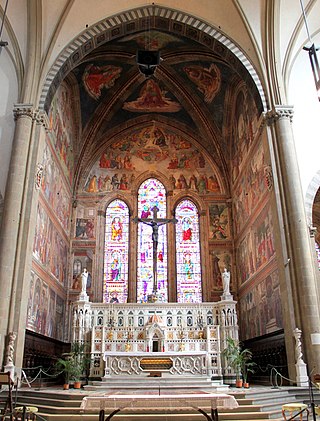
The Tornabuoni Chapel is the main chapel in the church of Santa Maria Novella, Florence, Italy. It is famous for the extensive and well-preserved fresco cycle on its walls, one of the most complete in the city, which was created by Domenico Ghirlandaio and his workshop between 1485 and 1490.
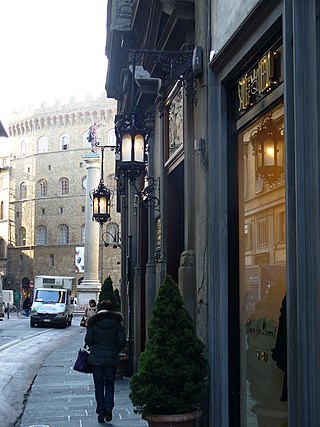
Via de' Tornabuoni, or Via Tornabuoni, is a street at the center of Florence, Italy, that goes from Antinori square to Ponte Santa Trinita, across Santa Trinita square, distinguished by the presence of fashion boutiques.

Palazzo dello Strozzino is a Renaissance palace in Florence, Italy. The stone Renaissance facade is located on Piazza degli Strozzi, diagonal to the Southeast corner of the imposing Palazzo Strozzi. The Northern façade on Via dei Anselmi houses the entrance to the Cinema Odeon.
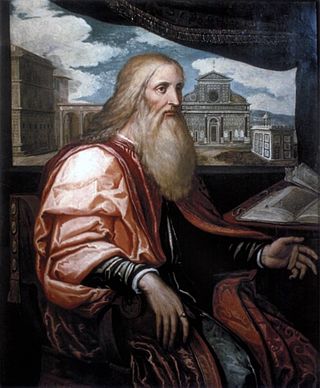
Giovanni Rucellai, known by his name with the patronymic Giovanni di Paolo Rucellai, was a member of a wealthy family of wool merchants in Renaissance Florence, in Tuscany, Italy. He held political posts under Cosimo and Lorenzo de' Medici, but is principally remembered for building Palazzo Rucellai and the Rucellai Sepulchre, for his patronage of the marble façade of the church of Santa Maria Novella, and as author of an important Zibaldone. He was the father of Bernardo Rucellai (1448–1514) and grandfather of Giovanni di Bernardo Rucellai (1475–1525).
This is an alphabetical index of articles related to the Renaissance.

Bindo Altoviti of the Altoviti family was an Italian banker and one of the most influential papal bankers of his generation. A patron of the arts, he cultivated close friendships with artists such as Benvenuto Cellini, Raphael, Michelangelo and Giorgio Vasari.

The Casino Mediceo di San Marco is a late-Renaissance or Mannerist style palace located on Via Cavour number 57 and via San Gallo in Florence, region of Tuscany, Italy.

The Mystical Nativity or Adoration in the Forest was painted by Fra Filippo Lippi around 1459 as the altarpiece for the Magi Chapel in the new Palazzo Medici in Florence. It is now in the Gemäldegalerie, Berlin, with a copy by another artist now hanging in the chapel. It is a highly individual depiction of the familiar scene of the Nativity of Jesus in art, placed in a mountainous forest setting, with debris from woodcutting all around, rather than the familiar stable in Bethlehem, and with the usual figures and animals around the mother and child replaced by others.